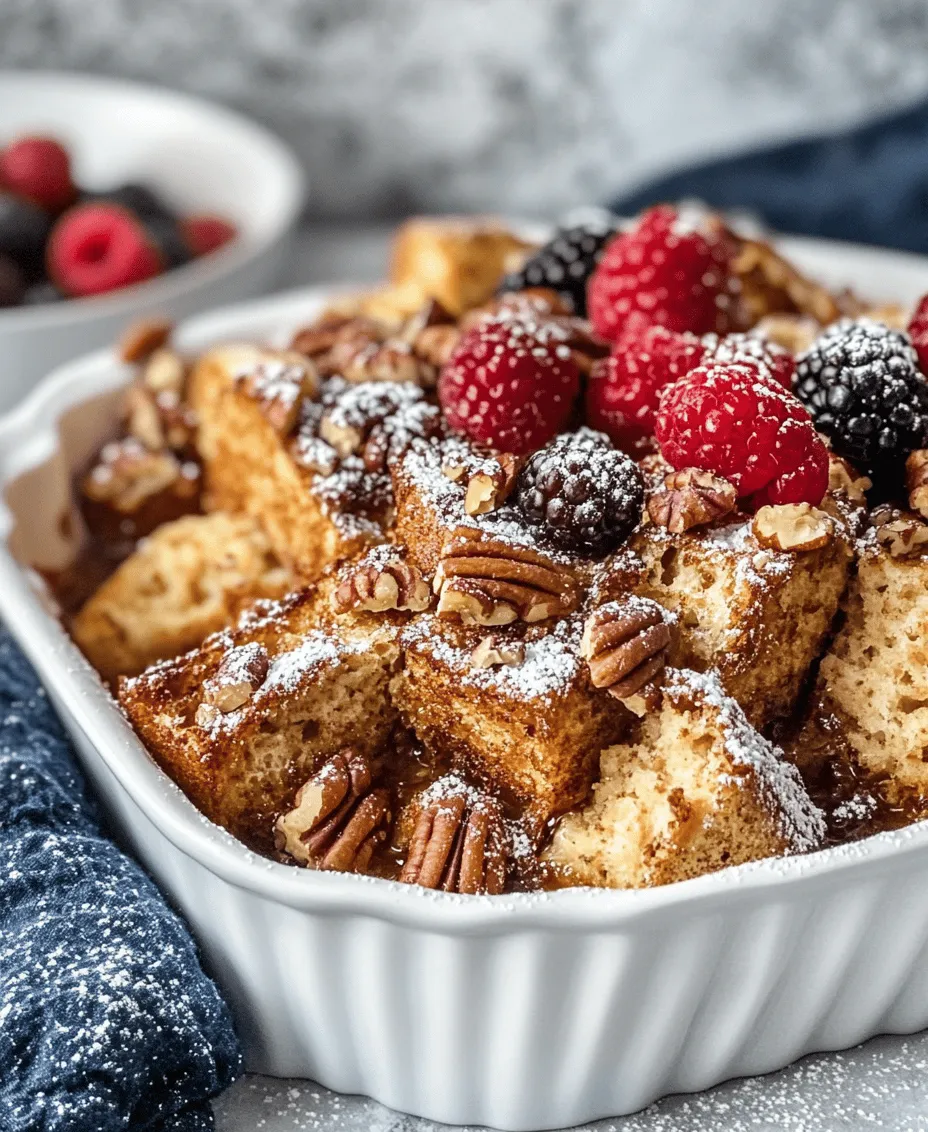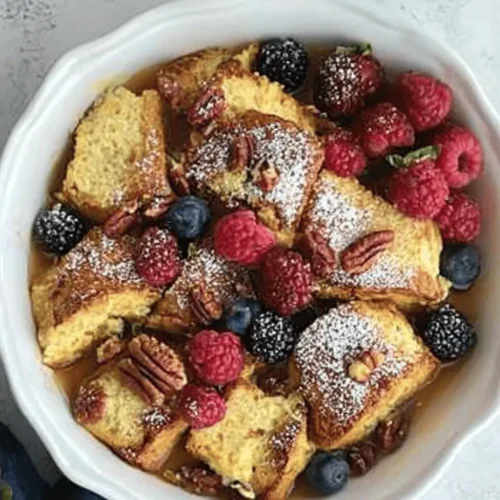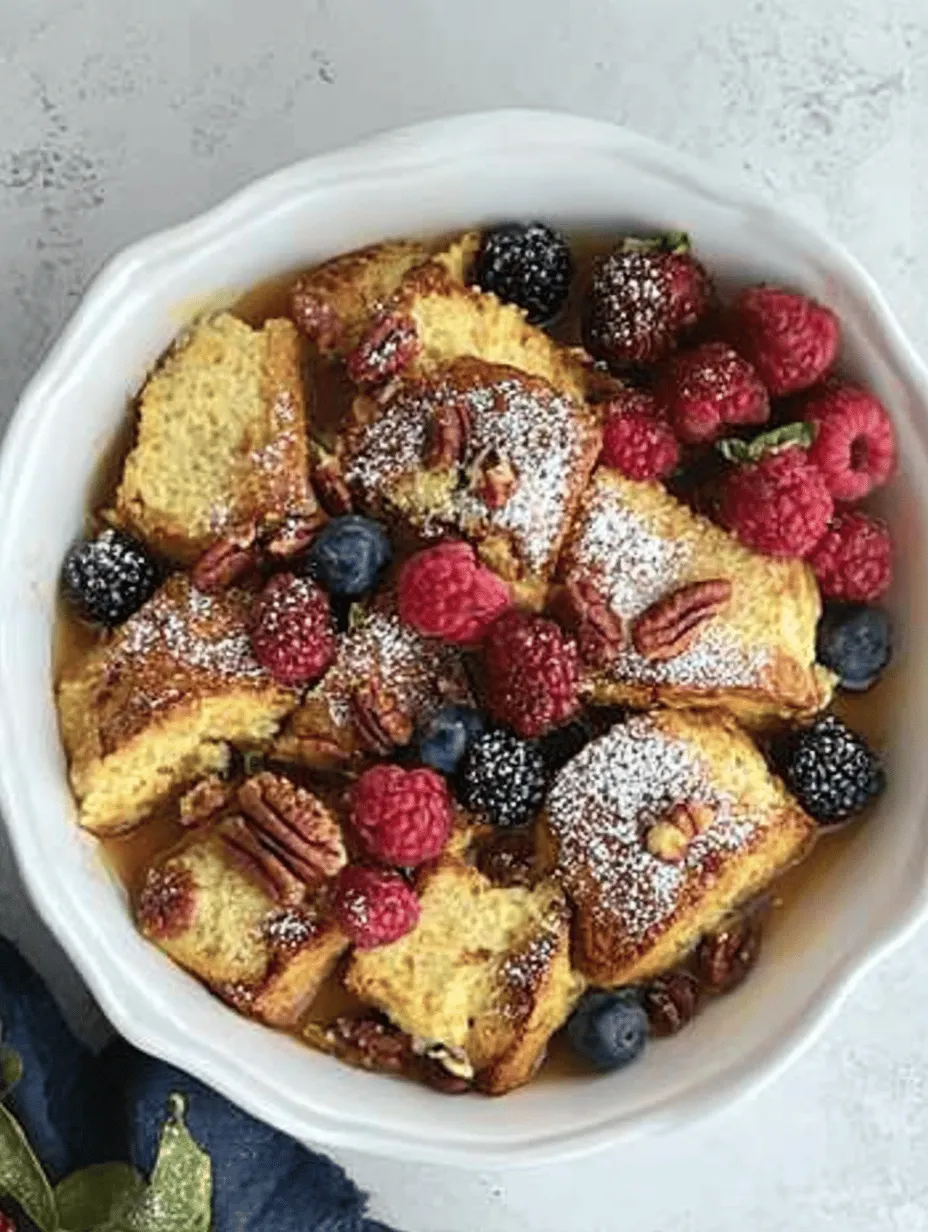Breakfast is often heralded as the most important meal of the day, and when it comes to creating a delightful morning experience, few dishes can compete with the charm of Overnight French Toast Casserole. This delectable dish is not only a feast for the eyes but also a treat for the taste buds, making it an ideal breakfast option for both busy weekdays and leisurely weekends. Imagine waking up to the comforting aroma of cinnamon and vanilla wafting through your home, knowing that a delicious, ready-made meal awaits you.
The beauty of Overnight French Toast Casserole lies in its ease of preparation. It allows you to combine all the ingredients the night before, letting the flavors meld beautifully while you sleep. This means that come morning, all you need to do is pop it in the oven and let it bake while you sip your coffee or enjoy a leisurely chat with your loved ones. Whether you are hosting a festive holiday brunch, a family gathering, or simply indulging in a lazy Sunday morning, this casserole is versatile enough to suit any occasion.
Understanding the Basics of French Toast Casserole
So, what exactly is a French toast casserole? At its core, it’s a baked version of the classic French toast, where bread is soaked in a rich egg and milk mixture before being baked until golden and custardy. The origins of French toast can be traced back to ancient times, with variations found in many cultures, but it was in France that it gained its name. The dish has evolved over centuries, with different regions adding their unique twists. The casserole form of French toast is a modern adaptation, allowing for bulk preparation and easy serving.
When it comes to crafting the perfect Overnight French Toast Casserole, selecting the right bread is crucial. Stale bread, especially French bread or brioche, is ideal for this recipe. The reason for this lies in the bread’s texture; stale bread absorbs the egg mixture better, ensuring that every bite is infused with flavor. Fresh bread, on the other hand, can become mushy and lose its desired structure during baking. Opting for a loaf that has had a day or two to dry out will yield the best results, creating a delightful contrast between the soft custard and the slightly crispy top.
Ingredients Breakdown
Before diving into the preparation, let’s take a closer look at the essential ingredients that come together to create this delicious casserole, as well as their roles in contributing to the final dish.
1. French Bread: The star of the casserole. As mentioned, stale French bread works best because its denser texture allows it to hold up against the egg mixture, preventing it from becoming overly soggy.
2. Eggs: A fundamental component of the recipe, eggs serve as the binding agent, providing richness and structure. They play a crucial role in achieving that custardy interior that is characteristic of a well-made French toast casserole.
3. Dairy: Whole milk and heavy cream are used to create a luscious, creamy base. Whole milk adds richness, while heavy cream enhances the dish’s indulgence, resulting in a decadent flavor profile that elevates the entire casserole.
4. Sweeteners: A blend of granulated sugar and maple syrup is often used to sweeten the dish. The sugar helps to caramelize the top during baking, providing a beautiful golden crust, while maple syrup adds a depth of flavor that complements the spices.
5. Spices: Cinnamon and nutmeg are essential for adding warmth and complexity to the flavor. These spices not only enhance the sweetness but also evoke the comforting essence of traditional French toast.
6. Optional Ingredients: For those looking to elevate their casserole, consider adding chopped pecans for a delightful crunch, a dusting of powdered sugar for a touch of sweetness, or fresh berries that can introduce a burst of tartness.
Step-by-Step Instructions for Preparation
Now that we’ve covered the basics and ingredients, let’s get into the step-by-step process of preparing your Overnight French Toast Casserole. This is where the magic happens, transforming simple ingredients into an extraordinary breakfast treat.
Step 1: Preparing the Baking Dish
Begin by preheating your oven to 350°F (175°C). Choose a 9×13-inch baking dish for this recipe, as it provides ample space for the bread and custard mixture. Lightly grease the baking dish with butter or non-stick cooking spray to ensure easy removal of the casserole once it’s baked.
Step 2: Cubing the Bread
Next, take your stale French bread and cut it into 1-inch cubes. The size of the cubes is crucial; they should be uniform to ensure even soaking and baking. If your bread is very stale, you may find it easier to tear the bread into pieces instead of cutting it. Place the cubed bread into the prepared baking dish, spreading it out evenly across the bottom.
Step 3: Whisking the Egg Mixture
In a large mixing bowl, crack a dozen large eggs and whisk them together until they are fully combined. Once the eggs are blended, add in your dairy mixture, which consists of whole milk and heavy cream. Whisk until smooth and well incorporated.
At this stage, add the granulated sugar, maple syrup, and spices—cinnamon and nutmeg. Whisk thoroughly to ensure that all the ingredients are evenly distributed. This mixture should be creamy and fragrant, with the spices enveloping the egg and dairy base.
Step 4: Combining Ingredients
Once your egg mixture is ready, pour it evenly over the cubed bread in the baking dish. Use a spatula or your hands to gently press down on the bread cubes, ensuring that they are fully submerged in the custard. This soaking process is vital; it allows the bread to absorb the flavors and moisture, resulting in a rich and custardy texture after baking.
Step 5: Soaking the Bread
Cover the baking dish with plastic wrap or aluminum foil and place it in the refrigerator for at least 4 hours, preferably overnight. This soaking period allows the bread to fully absorb the egg mixture, maximizing flavor and texture. If you are short on time, aim for a minimum of 30 minutes, but remember that overnight is ideal for the best results.
With these initial steps completed, your Overnight French Toast Casserole is well on its way to becoming a breakfast sensation. The next phase will involve baking it to perfection, enhancing its flavors, and creating that irresistible golden crust. But before we delve into that, let the anticipation build as you imagine the delicious aroma that will fill your kitchen come morning.

Chilling the Casserole Overnight for Best Results
Once you’ve prepared your Overnight French Toast Casserole, it’s crucial to let it chill in the refrigerator overnight. This step is essential as it allows the bread to soak up the egg mixture fully, resulting in a custardy texture that is both moist and flavorful. It also gives the flavors time to meld together, creating a more harmonious taste.
For best results, cover the casserole dish tightly with plastic wrap or aluminum foil to prevent any unwanted odors from the fridge from seeping into your dish. If you’re short on time, aim for at least 4 hours of chilling, but overnight is highly recommended for the ultimate flavor and texture.
Baking the Casserole
Guidance on Preheating the Oven and Preparing for Baking
When you’re ready to bake your casserole, preheat your oven to 350°F (175°C). Preheating is crucial as it ensures that your casserole cooks evenly. While the oven is heating up, remove your casserole from the refrigerator and let it sit at room temperature for about 20-30 minutes. This helps to take the chill off, allowing it to bake more evenly.
If you haven’t done so already, prepare your baking dish by lightly greasing it with butter or cooking spray. This step will help prevent the casserole from sticking and make for easier serving.
Visual Cues to Look for During Baking to Indicate Doneness
Once your casserole is in the oven, you’ll want to keep an eye on it. Bake for approximately 45-55 minutes. Look for a few key visual cues to indicate that your casserole is done:
– Golden Brown Top: The top should be a beautiful golden brown, indicating that it has developed a slight crust.
– Puffed Up: The casserole will puff slightly as it bakes. This is a good sign that the egg mixture has set.
– Firm Center: Gently shake the casserole; it should be firm in the center and not jiggle excessively. If it still appears runny, give it an additional 5-10 minutes in the oven.
Importance of Allowing the Casserole to Rest Before Serving
Once your casserole reaches that perfect golden brown and firm texture, remove it from the oven and allow it to rest for about 10-15 minutes. This resting period is vital as it helps the casserole set even further, making it easier to slice and serve. Cutting into it immediately may cause it to fall apart, leading to a less appealing presentation.
Serving Suggestions
Traditional Serving Ideas
When it comes to serving your Overnight French Toast Casserole, the classic approach is to drizzle it generously with pure maple syrup. The rich, sweet flavor of the syrup complements the custard base beautifully, enhancing the overall taste of the dish. For an added touch, dust with powdered sugar before serving for a delightful presentation.
Creative Variations
Feel free to get creative with your serving options. Consider adding fresh berries such as strawberries, blueberries, or raspberries on top of each serving for a burst of freshness. Whipped cream can also bring a light, airy texture that pairs wonderfully with the richness of the casserole.
For those who enjoy flavored syrups, try infusing your maple syrup with vanilla or cinnamon for an extra layer of flavor. You could even serve the casserole with a side of yogurt for added creaminess and protein.
Suggestions for Pairing with Beverages
To round out your breakfast experience, consider what beverages to serve alongside your casserole. A hot cup of coffee is a classic choice, providing a perfect balance to the sweetness of the dish. If you prefer something lighter, fresh-squeezed orange juice or a fruit smoothie can add a refreshing twist to your meal.
Nutritional Information
Overview of the Nutritional Content of the Casserole per Serving
Understanding the nutritional content of your Overnight French Toast Casserole can help you enjoy it in a balanced way. Generally, each serving contains approximately 350-400 calories, depending on the specific ingredients and portion size. The casserole is rich in carbohydrates from the bread, protein from the eggs and milk, and fats from the butter and any toppings used.
Discussion on Calorie Count, Macronutrients, and How It Fits Into a Balanced Diet
In terms of macronutrients, you can expect around 15-20 grams of protein, 15-20 grams of fat, and 50-60 grams of carbohydrates per serving. This makes it a hearty breakfast option, perfect for fueling your day. While it is indulgent, moderation is key, and pairing it with fresh fruit or a protein source can help balance your meal.
Considerations for Dietary Restrictions
For those with dietary restrictions, there are plenty of ways to adapt this recipe. For gluten-free options, substitute standard bread with gluten-free bread, ensuring that all other ingredients are also gluten-free. Additionally, those who are lactose intolerant can use plant-based milk and dairy-free butter alternatives to maintain the dish’s creamy texture without the dairy.
Cultural Variations of French Toast
Exploration of How Different Cultures Approach French Toast
French toast is a beloved breakfast dish that has transcended cultures, leading to many regional variations and adaptations worldwide. Each culture brings its unique flair to this simple yet delightful dish.
French “Pain Perdu” and Its History
In France, French toast is known as “pain perdu,” which translates to “lost bread.” This name reflects its origins, as it was originally created to utilize stale or leftover bread, preventing food waste. The French version often incorporates a creamy custard made with milk, eggs, and sugar, sometimes flavored with vanilla or orange zest, and is typically served dusted with powdered sugar or topped with fresh fruit.
American Adaptations and Unique Local Recipes
In the United States, French toast has taken on a life of its own. While the traditional method remains popular, many regional adaptations have emerged. For instance, in the Southern states, you might encounter French toast made with brioche or challah, often served with caramelized bananas or pecans. The West Coast has introduced variations that include toppings like avocado or even savory ingredients, pushing the boundaries of what French toast can be.
Variations in Toppings and Ingredients Across Different Regions
Throughout the world, toppings for French toast can vary dramatically. In some places, you might find it served with sweet syrups, while in others, savory ingredients like cheese or herbs are added. In Japan, “shokupan” (a fluffy white bread) is used, and it’s often served as a dessert with sweet toppings. In Mexico, “tostadas” may be served with cinnamon and sugar, evoking a festive spirit.
Conclusion
The Overnight French Toast Casserole is not just a breakfast dish; it’s a delightful experience that combines convenience, flavor, and the joy of sharing with loved ones. Its easy preparation allows you to spend more time enjoying the company of family and friends rather than being stuck in the kitchen.
This casserole encapsulates the essence of a communal meal, perfect for gatherings, holidays, or leisurely weekend brunches. The versatility of the recipe means you can customize it to your liking, experimenting with different breads, toppings, and flavors.
So, gather your ingredients, prepare your casserole, and let the magic happen overnight. We encourage you to try this recipe and make it your own, exploring the endless possibilities that come with each serving. Bon appétit!


